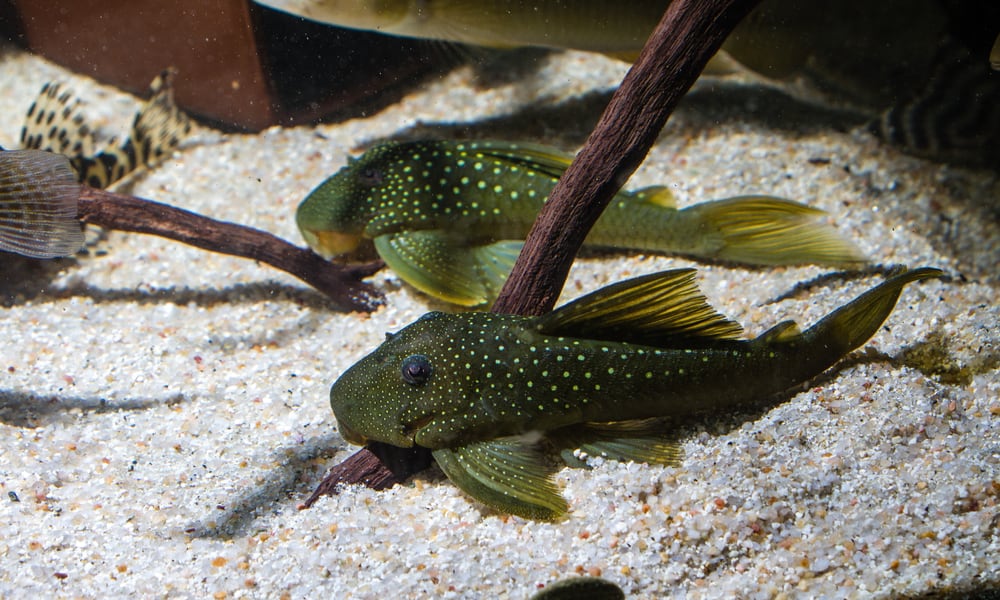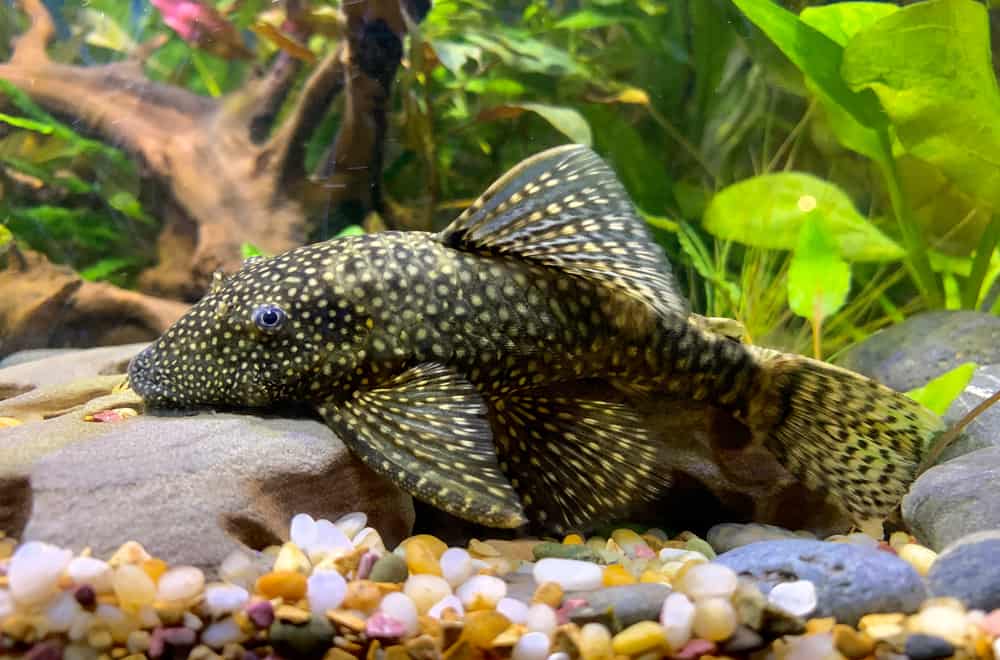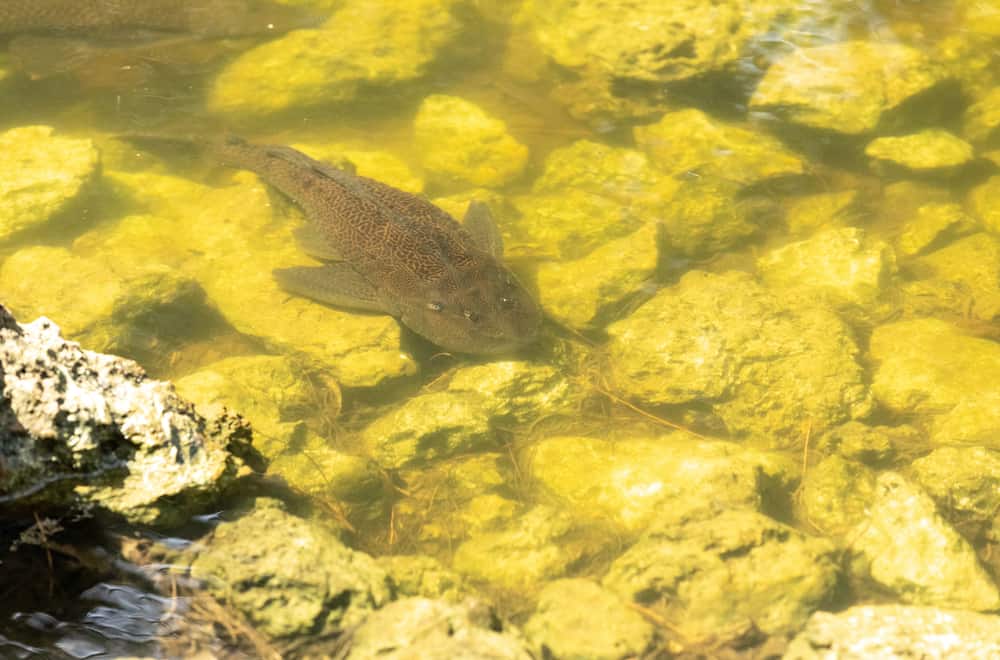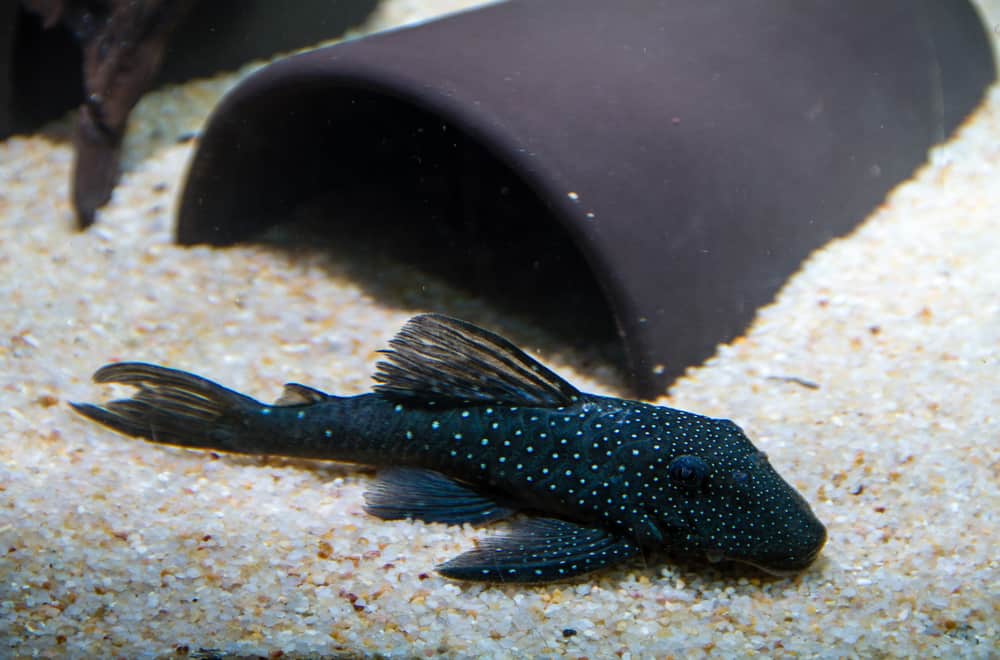Plecos are one of the most common fish species in aquariums. They are generally hardy and easy to care for, which makes them a great option for both beginner and experienced fish keepers. If you are planning on adding a couple to your fish tank, one of the things you might be wondering about is, “What do plecos eat?” Well, keep reading.
Plecos Habits and Biology
The Plecostomus fish, also known as plecos, are native to South and Central America, mostly residing in rivers and streams. You will mostly find them along the bottom of these waterways, hiding among rock debris, wood, and branches.
The majority of the plecos you find in fish tanks are wild-caught. They are mostly sold as juveniles of 3 inches in length, but they grow pretty fast, doubling their size in just 5 months.
There are more than 150 species of plecos. Depending on the type, plecos can grow 15 to 25 inches tall at maturity, meaning keeping these fish will require you to have a large, spacious aquarium.
It can be difficult to tell males from females, as both have the same body shape and features. Their body is narrow with a wide head, upright spiky dorsal fin, laterally-facing suckermouth, and strong caudal, abdominal, and pectoral fins.
The color will vary from species to species but the majority will be black, gray, brown, olive, or red-orange with camouflage patterns both on their bodies and on the fins.
One of the reasons plecos make excellent pet fish is that they are hardy species. Plecos can live for close to 10 years in captivity. Where there is enough space and they are well taken care of, plecos can live for up to 16 years.
When it comes to behavior, plecos have different temperaments at different stages of their lives. Juveniles are shy and will mostly hide during the day. As they grow, however, plecos become more aggressive and even territorial. Giant plecos will attack other species and even their own.
Plecos reproduce by laying eggs. They dig tunnels in mud banks to build nesting chambers or occupy natural caves created by rocks or driftwood. The females build the nests while the males guard the eggs.
Fun Fact: Plecos get along pretty well with most species except their own. They are particularly aggressive to species that they didn’t grow together with.
What Do Plecos Eat in Their Natural Habitat?
Plecos are algae eaters, and that’s one of the reasons they are so common in aquariums. They help keep the tank clean. In the wild, they dwell in the bottom of the ocean, feasting on algae, wood, and plant materials.
But this diet changes as the fish grow. Mature plecos love meat and will often attack smaller, weaker, or slower-moving fish for food.
If you notice smaller fish missing in an aquarium that has plecos, or find half-eaten bodies of the smaller fish, your plecos are the culprit. Just like in the wild, they will move to all corners of the tank hunting for food. But plecos in the wild will sometimes want to feed on something bigger and have been found to go for extremely large marine organisms including manatees.
Here is a video of plecos attacking an entire manatee:
What Do Plecos Like to Eat in the Wild?
Plecos are opportunistic scavengers that will eat anything they find on their way. Their diet mainly consists of:
- Algae
- Wood fiber
- Small crustaceans
- Small plants
- Scraps of meat from dead marine animals
- Small fish
How Plecos’ Diet Benefit the Ecosystem
Plecos mostly feed on algae. While certain algae are good for the marine ecosystem, some species produce toxins that can be harmful to fish and other animals that consume them.
The toxins can also cause illnesses in humans when seafood gets contaminated. And when marine organisms die from eating harmful algae, they fall to the seafloor, where they decay and start releasing compounds that lower oxygen levels in the water.
It is difficult to get rid of the toxic algae in the sea without first bringing down the number of good algae, as the good algae provide the nutrients the toxic algae needs to flourish.
By consuming the good algae, plecos help reduce it, and as a result, there is nothing to support the harmful algae. This helps minimize toxicity in the ocean, which gives rise to healthy marine creatures.
What Do Plecos Eat as Pets?
- Algae tablets: Because home aquariums do not produce sufficient algae, pleco owners must improvise. Luckily, there are algae tablets that can be bought from the pet store to provide the nourishment needed by mature plecos. These tablets sink at the bottom of the tank where the fish can easily find them.
- Vegetables: Some leafy vegetables like romaine lettuce or tops of celery are an excellent source of food for plecos. You could also give them sliced cucumber, parboiled peas, or parboiled zucchini. They make a great diet for the fish too.
- Meat: Plecos will enjoy meaty treats once in a while. Cut up shrimps, bloodworms, or earthworms and feed your pet at least two times a week. If you can’t find live food sources, buy shrimp pellets, frozen bloodworms, or freeze-dried bloodworms. However, keep in mind that plecos are herbivores and you should minimize the amount of protein you feed them on a daily basis.
- Goldfish: Plecos are attracted to the skin of goldfish. If you house them together, you will find plecos sucking on the exterior of the goldfish and if not properly fed, they may even kill the fish. For the safety of your goldfish, avoid keeping these two fish species together.
- Driftwood: Your plecos need fiber in their diet, so make sure to keep driftwood in the aquarium all the time. The fish will suck and scrape this off and the little pieces will aid with the digestion. You can buy driftwood from any fish or aquarium store.
Tips to Feed Plecos
1. Consider the Age and Size of Your Pleco
If your plecos are very young, they may do just fine with the algae in the aquarium, tablet algae, or food scraps you leave behind after feeding other fish. However, if you only have one juvenile pleco in the tank, you will need to feed more frequently.
Also, as your pleco grows and matures, you will need to introduce more food items to its diet and feed larger portions. A pleco will be considered mature when it reaches 24 inches.
2. Watch Your Pleco As They Feed
Once you have brought food to your pleco, observe them keenly to see if they gobble it down. If they immediately start to eat, chances are that they are overly hungry and may need more food. If they ignore the food, you may need to feed them less food or less often.
3. Do Not Keep Multiple Plecos in a Tank
Catfish like plecos are aggressive and will often fight each other if put in the same tank. Some fights may result in serious injuries while others may even cause death. If you must add other fish to the aquarium, let it be a different species. Plecos will generally get along with other species better than they will with their own species.
4. Wash All Vegetables Before Feeding Them to Your Pleco
No matter where you get your pleco veggies from, make sure to clean them thoroughly before feeding your pet. It is also important that you slice them into small pieces; it will make them easier to manage.
While at it, only give your fish the right fruits and vegetables. Do not offer acidic fruits and vegetables like oranges and tomatoes, as these can harm your fish. It is also important to avoid rotting or molding foods; these are toxic and can harm your pleco.
5. Change Water Frequently
Because plecos eat a lot, they produce a lot of waste, and it’s easy for toxins to build up in the tank water. Having a well-maintained filtration system may help keep the water clean, but you will still need to change the water at least once every 30 days to keep the tank healthy.
Fresh water will not only prevent bacteria but also provide a clean environment for your pleco and their tankmates to swim.
6. Feed Sick Plecos Fruits and Veggies
Zucchini and leafy greens and fruits like pears and apples are full of nutrients that can help sick plecos recover. Simply chop into small pieces and drop them into the bottom of the tank.
Summary
Plecos are beautiful creatures that have been gracing our aquariums for years. They majorly feed on algae, but in captivity, their diet mainly comprises of tablet algae, veggies, and meat. Wash your veggies thoroughly before feeding your plecos to get rid of chemicals and chop large food items into small pieces to make them easier to manage.




Plecostomus do attack other species of fish. They’re best kept by themselves. My Plecostomus is still alive today after 18 years & 4 months when we bought it as a juvenile in September 2004. It outlasted all the other fish that lived for a maximum of 1 – 2 years and we haven’t bought anymore fish since 2005.